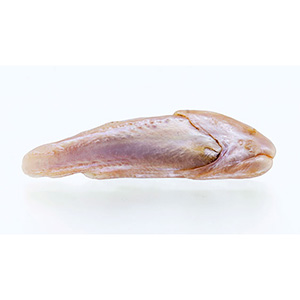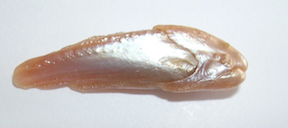
Note: this story is eight years old. Current information on the fish pearl can be seen here.
Last week, we brought you the story of a bizarre jewel that landed at the GIA lab—a natural pearl that looks uncannily like a fish.
Immediately afterward, I heard from its owner, French trader Cyrille Hamoniaux, who told me the story of this unique, brownish-orange object.
According to Cyrille, his father ran across the 2.12 ct. pearl in 1970 while buying a bag of freshwater pearls in Beirut, Lebanon. The fish-pearl is believed to have come from the Mississippi River, though how it ended up in Lebanon is a bit of a mystery.
Even so, his father was so entranced with it—especially the way it perfectly mimics a fish’s mouth, eyes, and scales—that he kept it as a souvenir.
“It was so spectacular,” says Cyrille’s wife Melinda. “He kept it with him all this time. He always wanted it near him.”

The fish-pearl photographed by Cyrille Hamoniaux
For years the father believed a fish skeleton resided in the pearl. Earlier this year, the family sent it to the GIA lab for analysis. And while the scientists there were suitably impressed—the pearl “showed a remarkable resemblance to a fish swimming,” they wrote in a lab note—they found it to be all pearl, no fish. Further, they found “no indications of work, such as polishing, that is sometimes performed to improve a pearl’s appearance.”
In the end, there is no logical explanation for why this particular pearl looks so much like a fish. Melinda says she’s still baffled.
“There is no reason,” she says. “All the experts say it’s not possible. It’s just the beauty of nature. Perhaps it’s the finger of God. Everything doesn’t have an explanation.”
The family now hopes to sell it. But that brings up yet another mystery: How does one value a fish-pearl?
“I think someone will have to make a proposal,” Melinda says. “It’s difficult to value something unique like this.”
[Top photo: Sood Oil (Judy) Chia/courtesy of GIA]
- Subscribe to the JCK News Daily
- Subscribe to the JCK Special Report
- Follow JCK on Instagram: @jckmagazine
- Follow JCK on X: @jckmagazine
- Follow JCK on Facebook: @jckmagazine